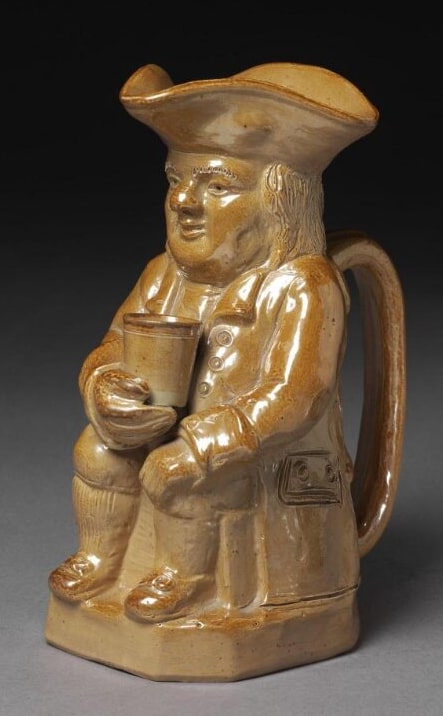 The first Toby Jug was made in the early to mid 1700s, and featured a jovial, seated, male figure, with a mug in his hand and a tricorn hat which made a pouring spout. He was dressed in clothes of the time; a long coat with low pockets, waistcoat, cravat, knee breeches and buckled shoes. No one really knows why he was named ‘Toby’ although it is possible he was named after Sir Toby Belch a character in Shakespeare’s Twelfth Night. Or maybe it was after a song popular in 1761, around the time the jug was first produced in a traditional, brown salt glaze version. The song ‘Brown Jug’ featured ‘Toby Fillpot’.
The first Toby Jug was made in the early to mid 1700s, and featured a jovial, seated, male figure, with a mug in his hand and a tricorn hat which made a pouring spout. He was dressed in clothes of the time; a long coat with low pockets, waistcoat, cravat, knee breeches and buckled shoes. No one really knows why he was named ‘Toby’ although it is possible he was named after Sir Toby Belch a character in Shakespeare’s Twelfth Night. Or maybe it was after a song popular in 1761, around the time the jug was first produced in a traditional, brown salt glaze version. The song ‘Brown Jug’ featured ‘Toby Fillpot’. Toby Jugs have been produced for many years, and although there is some dispute amongst collectors as to their exact origins, it is thought that the first ones were made around the early to mid 1700s. A Toby Jug is a full-length figure - more often than not male, although there are a few females too, and dressed from head to toe in the clothing associated with the 1700s: -a long frock coat, tricorn hat, knee-length breeches, waistcoat and neckerchief. He is usually depicted as a rather drunken character who is clutching a large beer jug, drinking glass or both. Sometimes he is holding a pipe or snuff box! Some collectors believe Toby Jugs are based on the character Toby Fillpot who was renowned for his drinking prowess.
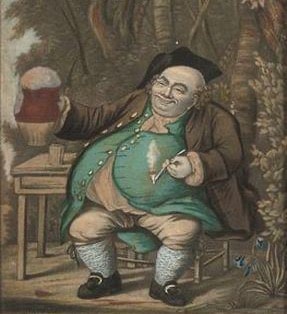
Toby Fillpot
Low Toby
Some collectors think there could be a connection to the "Low Toby" - similar to a Highway Man, but on foot rather than on horseback, the equivalent of the modern-day mugger!
Hearty Good Fellow
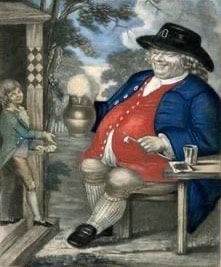
Other collectors believe he could be inspired by a number of illustrations of the time - a particular one being the one illustrated. This print entitled "The Hearty Good Fellow" is attributed to Francis Hayman (1708-1776). The title of the print is in fact also the name used for a Toby Jug.
"With my pipe in one hand & jug in the other
I drink to my Neighbour & Friend
My cares in a whiff of tobacco I'll smother
For Life you know shortly must end"
I drink to my Neighbour & Friend
My cares in a whiff of tobacco I'll smother
For Life you know shortly must end"
Smoking Club
 In the engraving (left) dating from the early 1800s, you can see a group of bawdy looking gentlemen who are smoking their churchwarden type pipes and drinking ale. If you look closely at the table to the right hand side of the picture, you can see a Toby Jug sat upon the table! This suggests that Toby Jugs may well have been used in Taverns and Clubs as a functional item for serving beer and ale and not just for decorative purposes.
In the engraving (left) dating from the early 1800s, you can see a group of bawdy looking gentlemen who are smoking their churchwarden type pipes and drinking ale. If you look closely at the table to the right hand side of the picture, you can see a Toby Jug sat upon the table! This suggests that Toby Jugs may well have been used in Taverns and Clubs as a functional item for serving beer and ale and not just for decorative purposes.Whatever the inspiration, the Toby Jug is generally depicted as a rather roughish character enjoying the excesses of the time in one way or another! - Be it drinking, smoking, taking snuff etc. Often they look a little "worse for wear" and their character illustrates what life was really like at the time, with many of them having pox marks, missing teeth etc.
The majority of collectors feel the best Toby Jugs were produced during the mid 1700s to mid 1800s, many of them with great skill and attention to detail in the modelling and painting. Some of the finest early jugs were produced in the Staffordshire Potteries in UK by the likes of Ralph Wood, Whieldon, Walton, Astbury etc and nowadays it is these jugs that can command high prices.
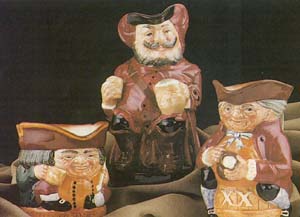 From the mid 1800s onwards, new techniques and mass production methods meant Toby Jugs were being more freely produced, and on the whole, these jugs are easier to find today, although, as with everything there are always exceptions. In addition, as potteries have come and gone, these jugs have become less available and therefore more collectable.
From the mid 1800s onwards, new techniques and mass production methods meant Toby Jugs were being more freely produced, and on the whole, these jugs are easier to find today, although, as with everything there are always exceptions. In addition, as potteries have come and gone, these jugs have become less available and therefore more collectable.Toby Jugs were revived by Doulton in the 1800s, who developed the idea into a range of character jugs. Today, their popularity shows no signs of waning and they hold their price at auction sales. Their appeal is wide reaching because Doulton jugs are varied both in their craftsmanship and their subject matter.
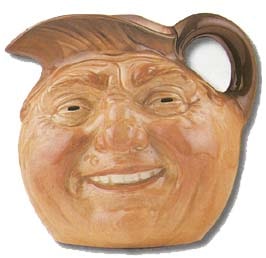 Doulton have made Toby jugs in the traditional manner since 1815 but in the 1920s Harry Simeon added colour. This inspired Charles Noke, a Doulton artist and modeller to rethink the Toby jug tradition. He envisaged a more colourful and stylish jug based on the head and shoulders of a character rather than the full figure. He had in mind characters from British song, literature, history and legend, designed to appeal to future generations. It took him almost ten years to be satisfied with the standards of design and production, but in 1934 the first character jug was launched. He chose as his subject John Barleycorn, a figure symbolising whisky.
Doulton have made Toby jugs in the traditional manner since 1815 but in the 1920s Harry Simeon added colour. This inspired Charles Noke, a Doulton artist and modeller to rethink the Toby jug tradition. He envisaged a more colourful and stylish jug based on the head and shoulders of a character rather than the full figure. He had in mind characters from British song, literature, history and legend, designed to appeal to future generations. It took him almost ten years to be satisfied with the standards of design and production, but in 1934 the first character jug was launched. He chose as his subject John Barleycorn, a figure symbolising whisky.It became an instant success and the range was added to with Old Charley, the Night Watchman, Sairey Gamp, Parson Brown and Dick Turpin. Two years later the first character jug modelled on a real person was made with Henry Fenton’s John Peel, a trend that has continued to the present day.
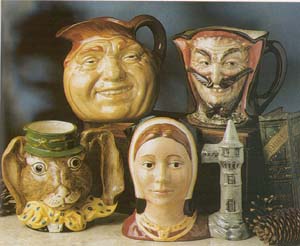 A feature of character jugs is their handle which often shows an elaborate diversity of applied decoration. However, this is a feature which has developed over the years. The first jugs generally had plain handles, with one or two exceptions, for some of the clown jugs had multi-coloured handles, Dick Turpin had a gun for a handle and the Cellerer a bunch of keys. It was during the 1950s that the handles achieved greater creative significance when Max Henk was involved in their production. His Long John Silver had a parrot handle and for the sake authenticity does not have an eye patch, sticking to Louis Stevenson’s book ‘ Treasure Island’.
A feature of character jugs is their handle which often shows an elaborate diversity of applied decoration. However, this is a feature which has developed over the years. The first jugs generally had plain handles, with one or two exceptions, for some of the clown jugs had multi-coloured handles, Dick Turpin had a gun for a handle and the Cellerer a bunch of keys. It was during the 1950s that the handles achieved greater creative significance when Max Henk was involved in their production. His Long John Silver had a parrot handle and for the sake authenticity does not have an eye patch, sticking to Louis Stevenson’s book ‘ Treasure Island’.The handles developed to tell more about the character and their associations, so the Dutchess from ‘Alice in Wonderland’ has a flamingo handle, the Mikado, a fan. More recently, the London ‘Bobby’ has both a whistle and Big Ben. The character jug from 1996 shows how far this trend has developed in the model of Jesse Owen who won four gold medals at the 1936 Olympics. This handle contains the Olympic torch, a contemporary US flag of the time and a banner inscribed with the name of the Olympic town ‘Berlin’.
Character Jugs Variations
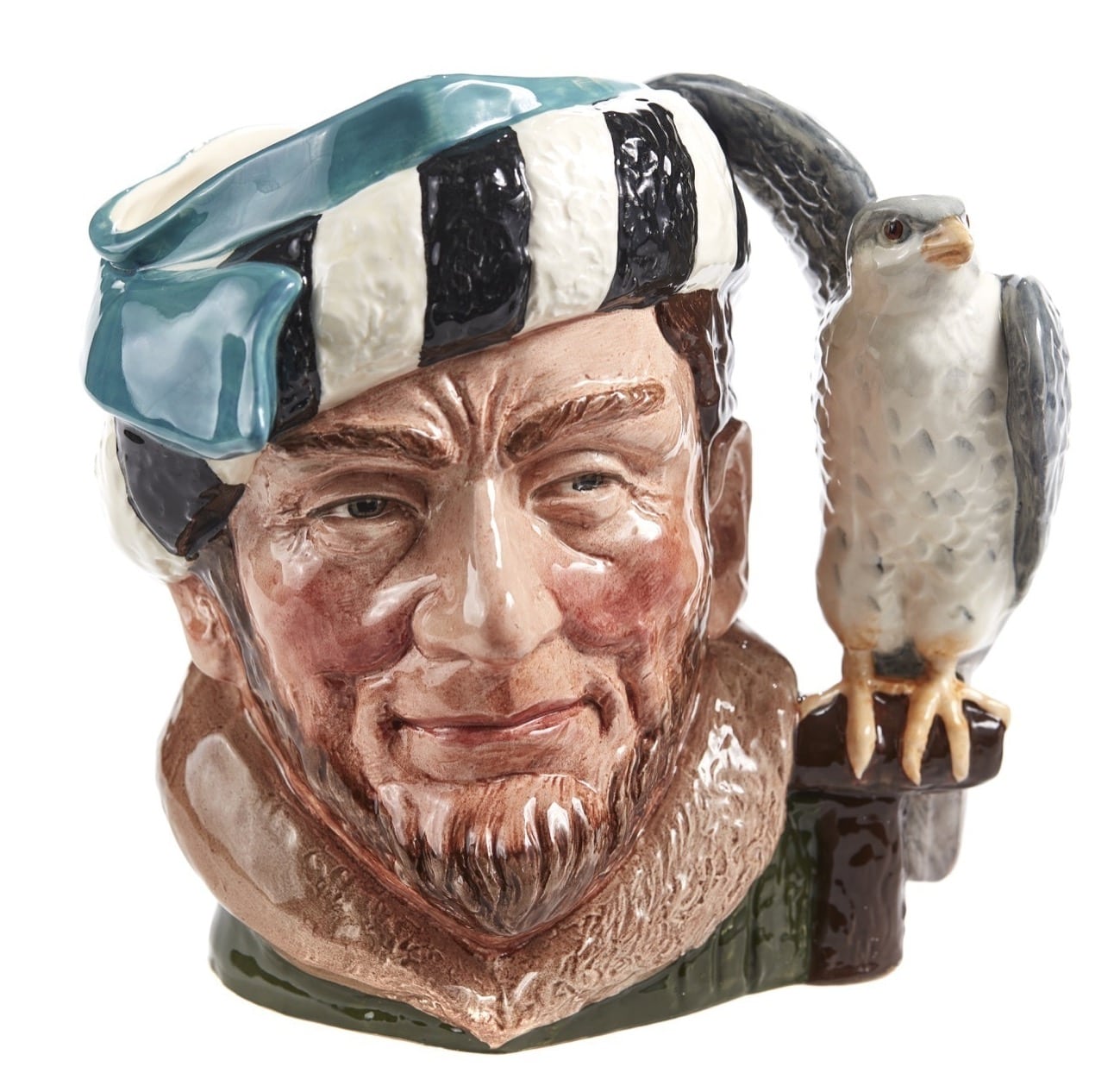
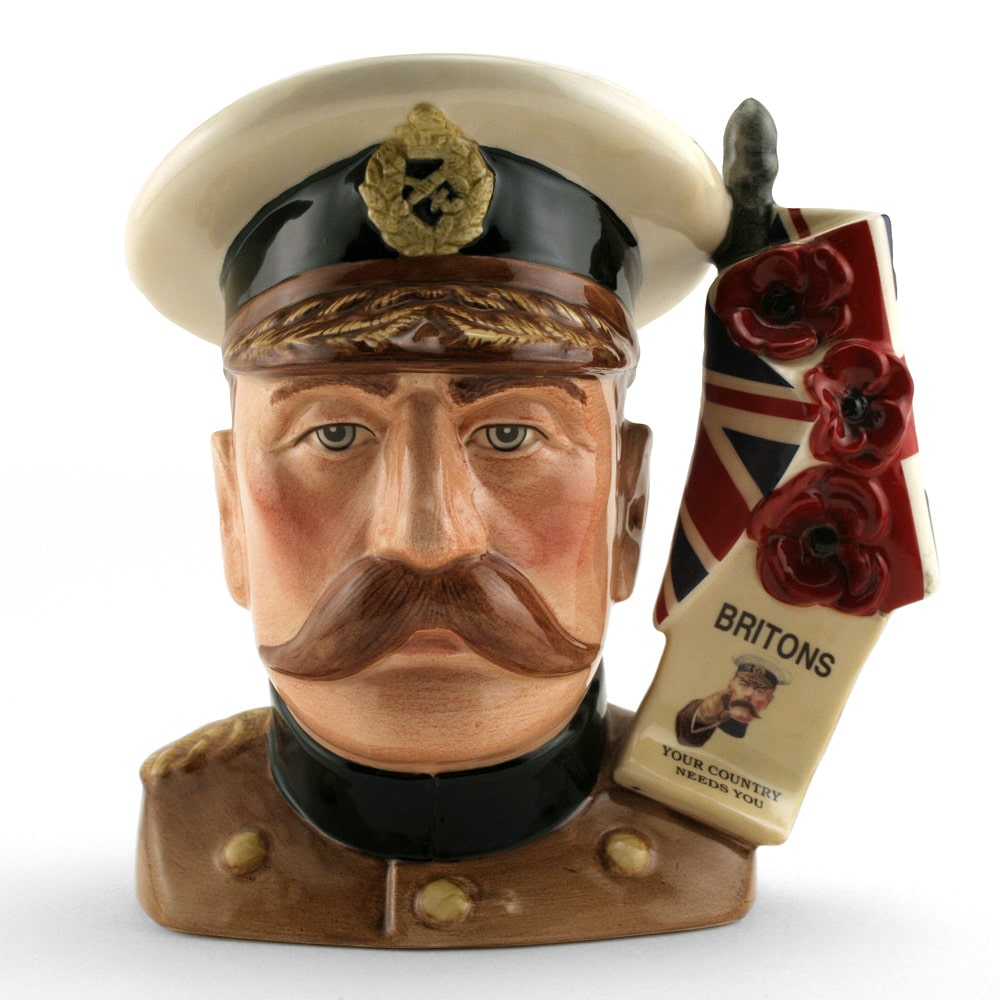 Sometimes variations have been made to handle design without altering the overall style of the jug. The Beefeater Guard who guards the Tower of London was introduced in 1947 and carried the initials GR on his handle for George Rex. In 1953 when Elizabeth II came to the throne, these were changed to ER, Elizabeth Regina. There was also a version with gold handle, now more valuable. In 1991 a completely new updated design shows the trend for more elaborate handles with its raven, the birds which legend says signify the fall of London should they ever leave the Tower.
Sometimes variations have been made to handle design without altering the overall style of the jug. The Beefeater Guard who guards the Tower of London was introduced in 1947 and carried the initials GR on his handle for George Rex. In 1953 when Elizabeth II came to the throne, these were changed to ER, Elizabeth Regina. There was also a version with gold handle, now more valuable. In 1991 a completely new updated design shows the trend for more elaborate handles with its raven, the birds which legend says signify the fall of London should they ever leave the Tower.Other handle variations which help to date the character jugs are the early versions of John Barleycorn. The first plain handle disappeared inside the jug at their top end. Later handles were attached to the outside. Early versions of Stairey Gamp have an ‘S’ at the bottom end of the handle. There have also been limited editions of handle design. Founder members of the Doulton Collectors Club were offered versions of John Doulton with the clock on the handle pointing to eight o’clock. Members who joined at a later date find the clock points to two o’clock.
Rare Character Jugs
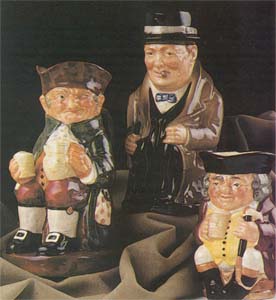 Other factors which aid dating and can affect value includes colour variations. For instance, the first clown range of jugs produced in the 1930’s had red hair and multi-coloured handles, but due to the war time restrictions on supply of materials, the hair during the war years was changed to brown. Between 1951 and 1955 hair colour had changed to white. Red or brown haired clowns are two-three times more valuable than the white ones, but the most valuable if the one-off black haired clown, commissioned by a family whose grandfather was a black haired clown. This was sold at auction a few years ago for £12,000.
Other factors which aid dating and can affect value includes colour variations. For instance, the first clown range of jugs produced in the 1930’s had red hair and multi-coloured handles, but due to the war time restrictions on supply of materials, the hair during the war years was changed to brown. Between 1951 and 1955 hair colour had changed to white. Red or brown haired clowns are two-three times more valuable than the white ones, but the most valuable if the one-off black haired clown, commissioned by a family whose grandfather was a black haired clown. This was sold at auction a few years ago for £12,000.Old King Cole designed by Harry Fenton had a yellow crown in 1938-1939 and a green handle and is vastly more valuable than the versions produced after until 1960, which had reddish-brown crown and handle. Even more valuable are the versions which contain musical movement, produced in 1939. One of these sold at Phillips for £1,092. The Mad Hatter, from Alice in Wonderland wore a black hat in the original but ten years ago a red hatted Hatter came to the market and was sold for over £6,000. It appears that in the 1960’s a painter in the factory changed the colour of the hat and this was produced for a short period before it was discontinued.
Another example are the colour variations in the buttons, hat coat and feather boa of Harry Fenton’s character jugs of the cockney pair ‘Arry and ‘Arriet which have made a big difference to the values.

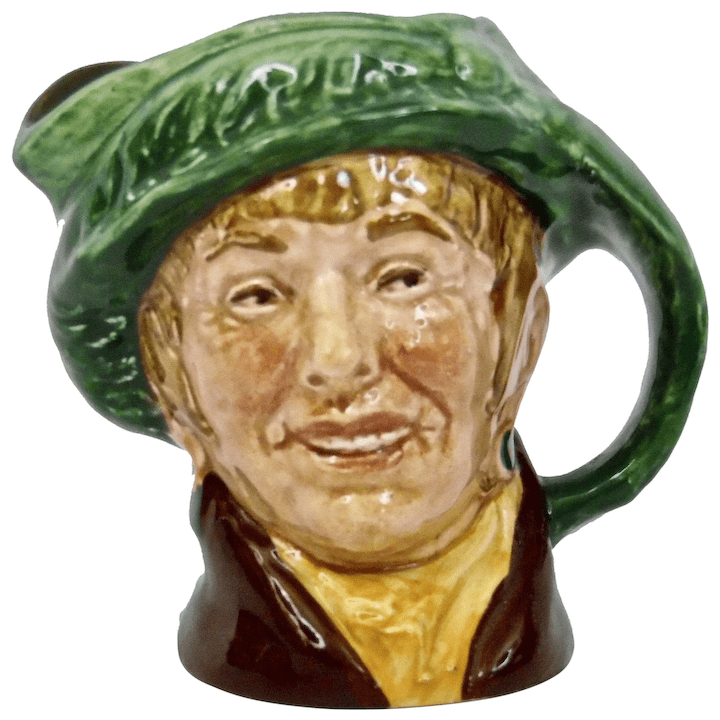
Arry Arriet
Occasionally, jugs have been discontinued after a limited period for an unexpected reason and this too affects the value. One notable example was in 1984 with the Clark Gable character jug, produced for the US market. Around 2,000 were sent to America as a trial but the likeness was not approved by his estate. Doulton recalled and destroyed all those unsold and stopped further production. Those which remained on the market now fetch £2,500 compared with other celebrity jugs of the time, including Mae West, Louis Armstrong, Jimmy Durante and Groucho Marx, whose likenesses fetch only a mere fraction of that figure. The exception is the original prototype of the Groucho Marx figure which included two of his brothers peering around the cigar shaped handle. High production costs led to their removal from the production line.
Another coveted jug which was withdrawn because the image was disliked, was that of Churchill, designed by Noke in 1940. Strictly speaking this was a loving cup rather than a character jug as it had two handles. Made in cream during the Battle of Britain, it was withdrawn after 18 months as Churchill was not pleased with it and today it has a value in excess of £6,000. Two coloured versions were also produced. One of these was sold at Sothebys a few years ago for £16,500. One of the rarest character jugs ever made, characterised a schoolboy Toby Gillette, who had his wish made true on the ‘Jim’ll Fix It’ programme. Only three copies were made. Two sold at Sotheby’s for £15,000 each the third is in the Royal Doulton Museum.

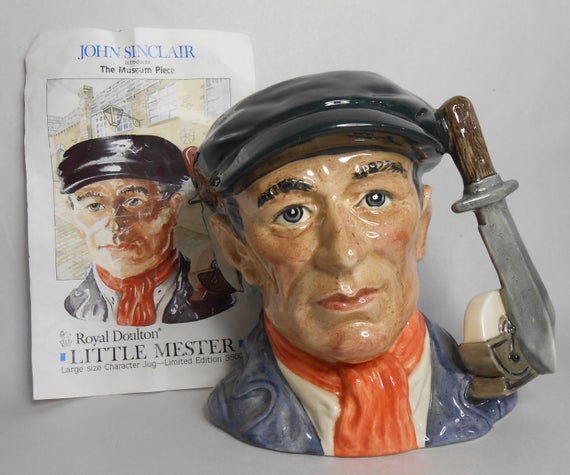

Merlin Little Mester Robin Hood
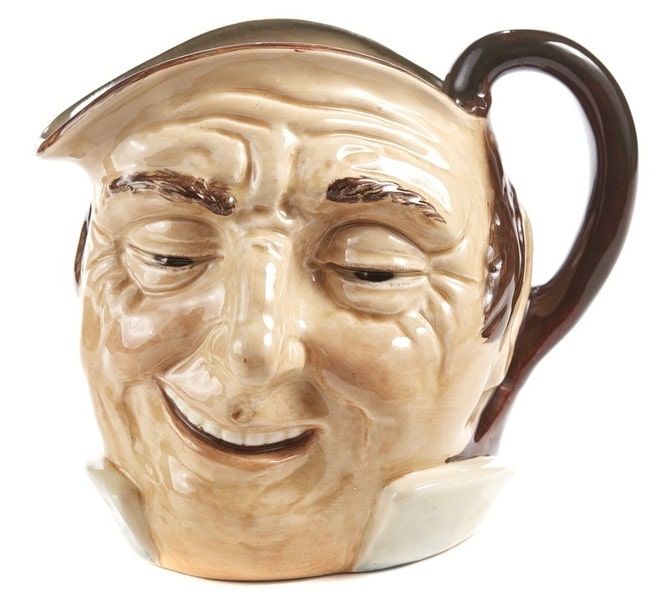
Farmer John
